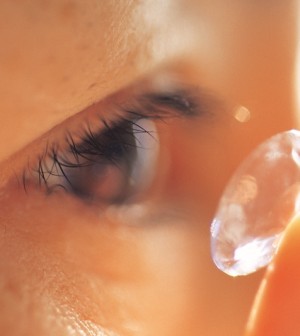- Skip Storing This Everyday Product in the Fridge Door
- Green Tea + B3 Pairing May Boost Brain Health
- Navigating Your Midlife Crisis: Embracing New Possibilities
- City Raccoons Showing Signs of Domestication
- Mapping the Exposome: Science Broadens Focus to Environmental Disease Triggers
- One Week Less on Social Media Linked to Better Mental Health
- Your Brain Changes in Stages as You Age, Study Finds
- Some Suicide Victims Show No Typical Warning Signs, Study Finds
- ByHeart Formula Faces Lawsuits After Babies Sickened With Botulism
- Switch to Vegan Diet Could Cut Your Greenhouse Gas Emissions in Half
Improper Contact Lens Use Causes Millions of Eye Infections: CDC


Millions of Americans misuse contact lenses — wearing them too long, not cleaning them properly — and that causes almost a million cases of eye infection in the United States annually, a new report finds.
These infections are clinically known as keratitis, an infection of the cornea, the clear dome that covers the colored part of the eye.
Keratitis can cause pain and inflammation and, in severe cases, even blindness, according to experts at the U.S. Centers for Disease Control and Prevention, who authored the new report released Thursday.
For the estimated 38 million Americans who wear contact lenses, the largest risk factor for this infection is the improper care of their lenses, agency experts said.
“Contact lenses offer many benefits, but they are not risk-free,” Dr. Jennifer Cope, a CDC medical epidemiologist, said during a news conference.
“Keratitis can be a scary infection, but it is preventable if people follow healthy habits and take care of their eyes and their lenses,” she added.
Some bad habits, such as sleeping with contact lenses, failing to clean and replace lens solution frequently, and letting contact lenses get wet while swimming or in the shower, greatly raises the risk for keratitis, Cope said.
For example, “people who wear their contact lenses overnight are more than 20 times more likely to get keratitis,” she said.
However, when treated quickly, most cases of keratitis can be cured easily without any lasting damage, she added.
Treatment can be pricey, though. According to Cope, the average doctor visit for the condition costs about $151 and the average emergency room visit costs $587.
In all, keratitis adds about $175 million to Americans’ health bills each year, she said.
For the report, CDC researchers analyzed three national databases of outpatient care centers and emergency rooms. Their efforts created, for the first time, estimates of how much keratitis occurs in the United States. They estimated that each year there are some 930,000 visits to doctors’ offices and outpatient clinics and 58,000 emergency room visits for eye infections.
More women than men saw their doctor for an eye infection (63 percent) and ended up going to the emergency room (55 percent), the researchers found. Keratitis affects all age groups, from teens to seniors, at about the same rate, the CDC team added.
Dr. Alfred Sommer is a professor of ophthalmology at Johns Hopkins University’s Wilmer Eye Institute in Baltimore. He described keratitis as “an injury or inflammation of the cornea, the clear part of the front of the eye through which we see.”
“There is no question that many people love to use contact lenses instead of spectacles. Using contact lenses, however, does carry the risk of infection and, in extreme cases, blindness,” Sommer said.
If keratitis is not treated quickly and effectively, it causes scarring, which interferes with vision, he explained. And “if it is not cured, it can perforate, and in the worst instances, the eye can be lost. Prompt recognition and treatment is essential. Patients are almost always aware of the problem since it generally causes significant pain, in addition to clouding of vision.”
Sommer cautioned that unclean lens carry-cases and sloppy cleaning practices can cause contamination of contact lenses and dramatically raise the risk of keratitis.
However, that risk can be minimized, he said, by being certain never to keep the contact lenses in the eyes overnight and being very careful to follow proper techniques for cleaning and storing them.
To prevent keratitis the CDC recommends:
- Washing hands with soap and water before touching contact lenses,
- Removing contacts before bed, showering or swimming,
- Rubbing and rinsing contacts in disinfecting solution after taking them out,
- Rubbing and rinsing the contact lens case with contact lens solution, drying the case and keeping it upside down with the caps off,
- Replacing lens cases at least every three months.
The CDC also recommends carrying glasses should contact lenses have to be removed.
The new report was published Nov. 14 in the CDC journal Morbidity and Mortality Weekly Report.
More information
For more on contact lenses, visit the U.S. Food and Drug Administration.
Source: HealthDay
Copyright © 2025 HealthDay. All rights reserved.










